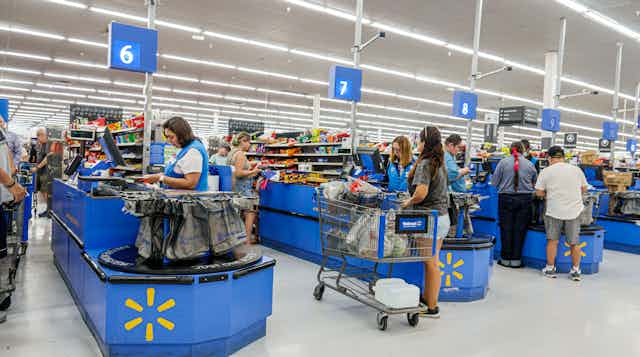If you live in the United States, chances are that cashiers often ask whether you want to donate to a cause their employer is currently supporting. Organizations like Children’s Miracle Network Hospitals, the Boys and Girls Clubs of America or relief efforts in Ukraine were among the causes retailers championed in 2022.
You may be asked if you’d like to round up your total to the nearest dollar, to add on a small amount or to “buy” a shamrock, heart or some other token that will be displayed in the store with your name on it. Sometimes these prompts are delivered by a credit card reader or a website during an online purchase.
According to Engage for Good, a social impact organization, 77 businesses raised over US$1 million each in 2022 from their customers for charity. These campaigns, the largest in the U.S., raised a total of $749 million. Checkout charity campaigns through eBay, Walgreens and PetSmart are among the nation’s largest.
We conduct research in the field of nonprofit management and charitable fundraising, and we wanted to know more about the people who say “yes” when asked to give at checkout – which we call “impulse giving.”
More than half give this way
As opposed to an impulse buyer, who buys things they weren’t planning to acquire while shopping, impulse giving is tied to the widespread instinct to help.
To learn more about the people who have collectively given hundreds of millions of dollars this way, we conducted a national survey of 1,383 American adults, the results of which will be published in a forthcoming article in the Journal of Public and Nonprofit Affairs.
We asked participants, who we found using Amazon’s Mechanical Turk platform, whether they gave at checkout, the amount they gave over the past year and how they donated. We also collected demographic information to create a profile of a typical impulse giver.

More than half of the respondents – 53% – said they had given to charity while paying for their purchases in the prior year. People who give this way say they donate about $50 to charities annually – about a dollar per week on average. The most popular form of checkout charity was rounding their total up to the nearest dollar: About 85% of these impulse givers told us that they did that.
More than two-thirds of the impulse givers we identified said that sometimes, instead of rounding up, they choose an additional amount to add on to their purchase, such as $1. Only about one-fifth of the people who support charities at checkout said they had purchased tokens for in-store display.
Of those who said they engaged in checkout charity, about 59% said they give to charity in multiple ways throughout the year.
Who are the impulse givers?
We found that checkout charity seems to appeal most to people under 50 years old and those who are middle-class wage earners – earning from $35,000 to $99,000 a year.
Those who had attended college were slightly less likely to give at the register than other survey respondents.
These patterns are different from those who give directly to charitable organizations. People who are older, earn higher incomes and have more years of higher education are more likely to donate directly to charitable organizations.
We also found that women are also more likely to give – and to give more – with checkout charity than men.
We found additional demographic differences in the amount of money generally donated. We found that, on average, white respondents gave $167 a year, while Black respondents gave $225 – but it’s possible that other factors, such as age and income, may play a role in those decisions. When we controlled for the influence of other demographic factors, we found that Black people taking part in our survey were spending approximately $120 a year more on impulse giving than white people reported. Blackbaud, a fundraising software company, has also found that Black Americans are more likely to engage in checkout charity than white Americans.
We also asked the survey respondents to think about the last time they donated while checking out and to tell us how familiar they were with the charity receiving their small gift.
Only 31% of impulse givers said they were “very knowledgeable” about the organization, with 12% of these small donors stating they had no familiarity at all. The majority had at least some awareness about the organization that would receive their money.
Can there be too many asks?
According to Engage for Good, the total raised from the largest checkout charity campaigns has grown each year since 2012.
However, the increased frequency of customers being asked to give to charity when they check out may instill complacency – or possibly, annoyance. Customers are now so used to being asked to give at checkout that they may be starting to act less impulsively.
For some shoppers, including those who participated in our study, the impulse to give may eventually yield to the ability to more easily say “no thanks.”

